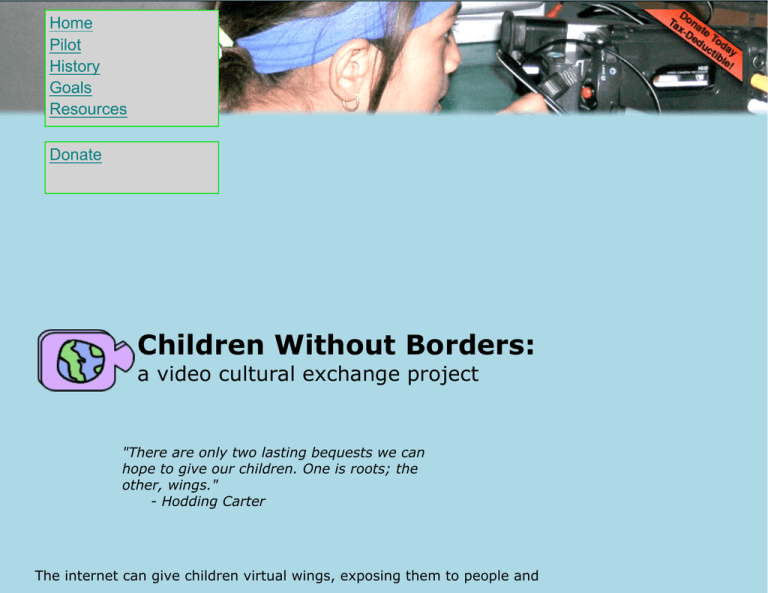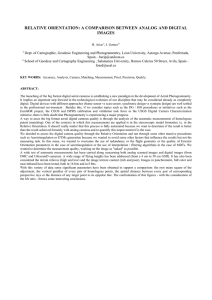Children Without Borders: a video cultural exchange project Home Pilot
advertisement

Home Pilot History Goals Resources Donate Children Without Borders: a video cultural exchange project "There are only two lasting bequests we can hope to give our children. One is roots; the other, wings." - Hodding Carter The internet can give children virtual wings, exposing them to people and information from around the globe. Our goal is to let kids value their heritage by exploring and sharing it globally with other kids. Children Without Borders is a student-driven program encouraging the development of global literacy, through collaborative video production and sharing. The goal is to allow children around the world to share stories with each other and to learn about themselves. Vision: This project is inspired by a video collaboration project organized by Debi Taylor, a Spanish teacher in California. She established a relationship between the children in her Spanish classes and several children in a small Mexican village. As the video courier, she travelled between the two locations, shooting and transporting footage of the children. Her intuitive ability to film the kids doing interesting activities, as well as organize performances and video letters between them created a very strong and entertaining relationship between the two groups of children. While this model allows for a wonderful experience for all involved, it is difficult to scale. It relies on an artistic and creative teacher with the time and resources to travel between two locations and bridge these communities. Children Without Borders gives the cameras and vision to the children themselves and relies on the internet for the sharing, discussion, and collaboration of the videos. By putting technology directly into the hands of children, giving them access to the infrastructures of globalization, and giving them control over the process, good things will happen. These good things include bottom-up peer-to-peer education resulting in a shift of power from centralized systems to the people who themselves are experiencing the effects of globalization. The result is a more literate, well-informed, empowered, and articulate public more able to identify their own needs, and to communicate them to effect changes. Pilot: The pilot program will work with a number of students in Mexico and the United States. This is a video-based cultural exchange project to allow children to value their own cultures and stories, while at the same time learning about the cultures and stories of other children around the world. By giving kids their own video cameras, you give them the ability to own the entire process from video creation to editing and production. By adding an environment in which to share and discuss their media, you create a platform for natural dialogue and cross-cultural communication around specific and personally meaningful events that they have chosen to document. The goal of the pilot project is to experiment with the limits of low-cost and low-maintenance technology to facilitate its widespread adoption. This involves exploring the video camcorder technology, video editing software, infrastructures for connectivity and sharing of video, as well as environments for discussion and collaboration. The goal is to limit the amount of expert mediation required to sustain long term communication between the students by allowing the interactions to be organic and born of their desires and interests. History: Various other intercultural exchange programs have been implemented in the past. The simplest precursor is the pen pal. There is something very personal about receiving a piece of correspondence that has travelled around the world from someone you have a relationship with. E-mail projects have established e-pen-pals. E-mail allows much more widespread and rapid communication, yet it lacks some of the emotional connection of a hand-written letter. Photography projects, likewise, have given children cameras to allow them to create and share their stories. Video allows a very different kind of emotional hook that is very powerful and personal. Goals: There are four goals of this project. They are: ● ● ● to increase cultural awareness to facilitate organic language learning to create and hone technical skills ● to develop topical expertise Resources: This project has a range of needs, from physical technology, to technical skills, to ideas and help bringing them to fruition. Here are some of the resources and tips we have found. The project aims to minimize the cost and maintenance of a video exchange project. This is possible thanks to the decreasing costs of technology and the evolution of online services for sharing video and fostering collaboration. The other key is the right amount of facilitation to harness children's creativity and curiosity. Some care must be taken in the choice of cameras and software Cameras The price of digital camcorders has drastically dropped to the point that a decent camera can be purchased for under $100. The compromises come in terms of quality and durability. There are a number of metrics to consider which can make the process seem complicated and confusing. Ultimately it is best to try the camera to see what the quality is, how it feels to shoot video with it. Many things affect the quality of the video shot by a camera. The framerate and resolution both have an immediate effect on the video. The lens' ability to focus close up and at large distances impacts what kind of shots you can take. The presence of a tripod port allows more stable footage to be shot with a tripod. The microphone quality is also important, and a flash is useful addition. The ability to take high quality still images is also a major selling point, as still images work very well when montaged with video footage. A host of companies make low-cost cameras of varying quality. Some of the cheapest cameras are made by Aiptek with a super low end Pocket DV at just $25. This camera was too low end for our project, so we opted for the next tier of cameras in the $60-$70 range. The Pocket DV4100M, $69, shoots MPEG4 video and records on an SD memory card. A 512 MB SD card for $25, brings the total of each kid to around $100. Another inexpensive camera line is made by Mustek. Video Sharing ● ● ● Flickrs of Video: a comparison of different video sharing websites Our Media: a site produced by the Internet Archive You Tube: a commercial video sharing application. Video Editing Software ● ● iPhoto Windows Movie Maker Film editing tips Donate: Children Without Borders could use your help. Your tax deductible donation is greatly appreciated and goes directly to purchasing cameras for kids. Please consider the following donations: $100gets one kid filming today with a video camera and a memory card$70is enough to buy a digital video camcorder $25buys a reusable memory card so a kid can shoot for an hour Any level of donation is sincerely appreciated. Please make checks out to: Children Without Borders c/o Cambridge Community Television 675 Massachusetts Ave Cambridge MA 02139 People: This project is being coordinated by Seth Raphael with the assistance of teachers in Sayulita, Nayarit MX and Cambridge Massachusetts. Special thanks to Cambridge Community Television, Bakhtiar Mikhak, Larry Fallon, Jay Silver, Debi Taylor, Esther Perez-Zemmels and the members of TTSR. Putting a face on globalization


